The Waterhen Bloa is a classic North Country spider fly pattern that dates back over 200 years (originally known as the Dark Bloa and a few other names).
It has been one of my favourite trout and grayling flies since I started tying and fishing it on the River Wharfe half a century ago.
A few years back I read an article by Paul Proctor where he’d modified the fly by adding a pearly butt. I’ve tested his modern version on the Welsh Dee, and the results have been…
nothing short of Spectacular.
To the extent that, now, I almost exclusively fish the Pearly Butt Waterhen Bloa.
This fly catches trout once the Large Dark Olives appear on the river. Also, it continues to work until the end of the season whenever olives are hatching.
So, let’s take a look at…
How to tie the Pearly Butt Waterhen Bloa
Tying material list:
- Hook: #14 & 16 Kamasan B402
- Thread: Waxed yellow silk
- Butt: Three turns of Mylar tinsel
- Body: Natural mole fur very lightly dubbed
- Hackle: Waterhen wing undercover feather (Starling is a reasonable substitute for Waterhen)
Step-by-step fly tying instructions:
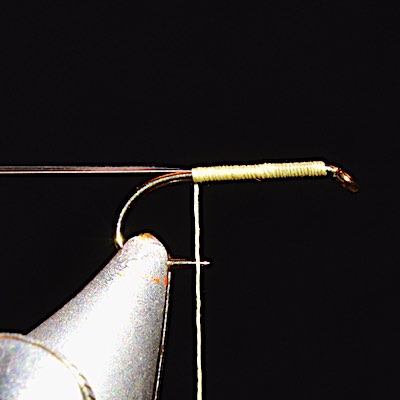
Step 1. Place the hook firmly in the vice and start the thread 1mm behind the eye. Wind the thread down the hook shank in touching turns and catch in a length of Mylar tinsel opposite the hook point.
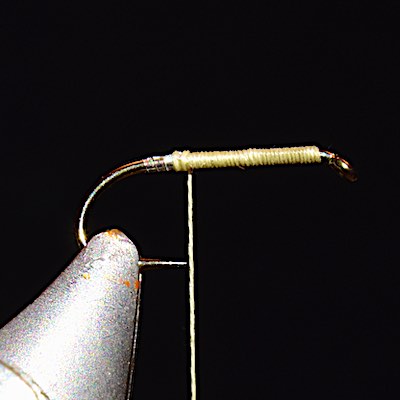
2. To form the pearl butt, wind the Mylar tinsel towards the hook bend and back to the tying thread. Secure the Mylar with the thread and trim off the waste.

Step 3. Wax the silk thread and sparsely apply some mole fur dubbing to it. I achieve that by just touching the thread with the mole fur. You should be able to see the thread through the fur.
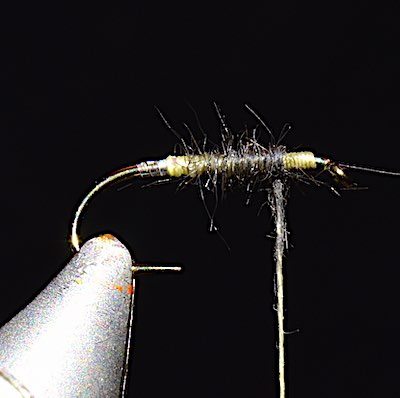
Step 4. Wind the thread up the hook shank to about 2mm short of the eye. You should be able to see the thread through the dubbing. When wet, the two layers of light and dark will blend perfectly.
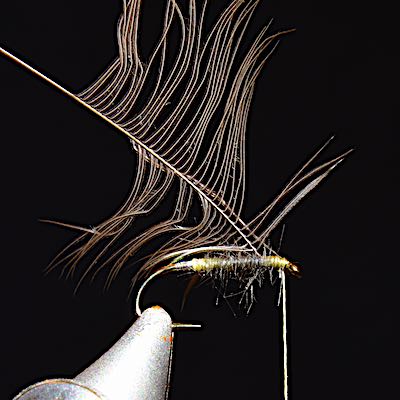
Step 3. Prepare the hackle by removing unwanted flue from the stem base then gently stroke the fibres forward to rest at right angles of the stalk. The fibres should extend just past the bend when tied in. Tie in the tip of the feather with a few turns of waxed thread.
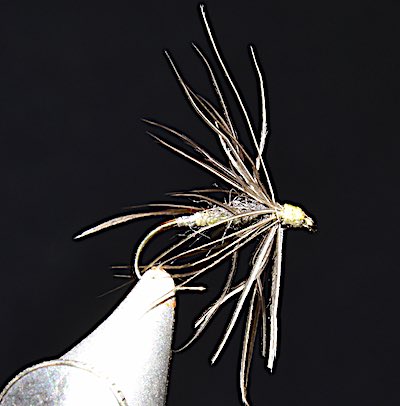
Step 4. Take hold of the hackle butt with hackle pliers and wind on two and a half turns towards the eye. Tie off the hackle with a couple of turns of waxed thread. Finally, form the head with the thread, whip-finish, and apply a drop of varnish to the head.
There seems to be a lot of debate on how many tuns of hackle to use when tying soft hackle flies. All I will say is that I’ve caught fish on flies with one turn of hackle to three turns.
Recently Waterhen (Moorhen) wings have been difficult to source, When they’re not available, I’ve tied the fly with a variety of pale grey, soft feathers, and they still catch fish.
Also, I tie variants using the feathers from the outside (marginal covert) of a moorhen wing, which seems to work just as well as the traditional patterns.
Fishing the Pearly Butt Waterhen Bloa
Generally, the literature mentions that the WB is used during the early months of the trout season. It is a good representation of hatching Large Dark Olives and works best on cold, damp days when olives struggle free of the water surface.
It’s much more than an early-season fly because I catch trout and grayling throughout the year.
So how do I fish this spider…
Equipment-wise I use a 9ft 5# rod, a floating line, and a 9ft 5X copolymer leader, which has been cut back to 5ft from the butt end. At the end of the leader, I tie on two 3ft lengths of 3lb copolymer to form 2 droppers.
The Pearl Butt Waterhen Bloa is fished on the top dropper of a 3-fly cast from March to mid-April. Often with a pheasant tail nymph on the point and a black hopper on the middle dropper.
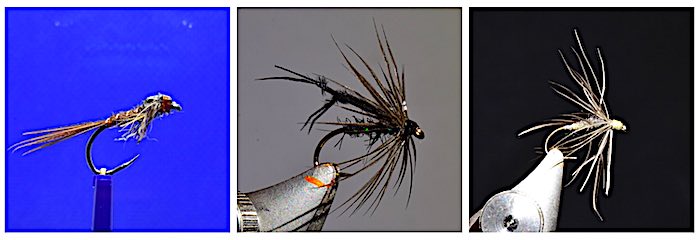
As the season progresses the black hopper is moved onto the point, and either a March Brown spider, Snipe Bloa, or Orange Partridge is fished on the middle dropper.
Wherever possible, it’s best to fish these spiders up and across the stream on a leader degreased with fuller earth to ensure it sinks.
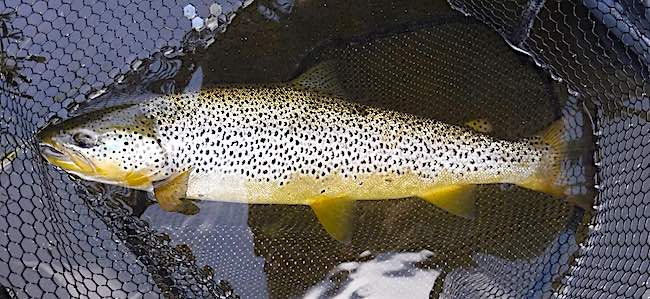
Finally, I hope this article stimulates you to tie the Pearly Butt Waterhen Bloa and test it on your local river or take a trip to fish the Welsh Dee where this North Country spider will catch trout and grayling throughout the year.
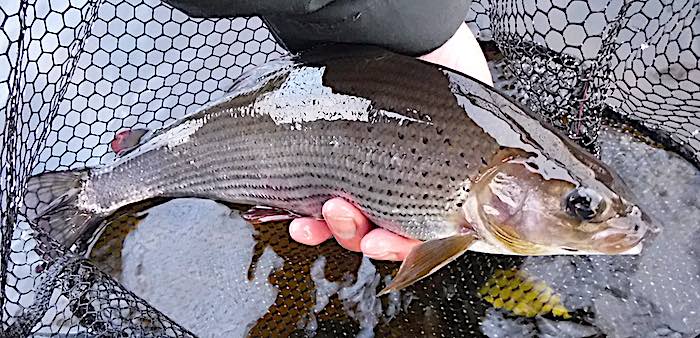
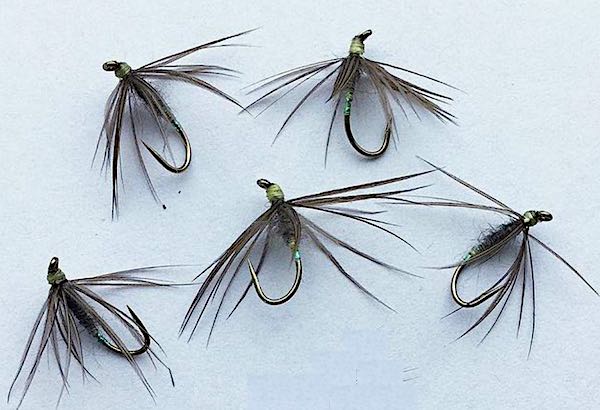
very good andrew something to look forward to
Hi Colin,
It’s looking like we should be able to get onto the rivers towards the end of March to wet a few flies.
Cheers, Andrew
Great article as always Andrew , the pearl butt or a touch of pearl anywhere on a fly always has the edge , the look of an air bubble or trapped oxygen just gives more life to the fly , plus it’s a good target for the fish , remember how successful the red tag used to be on the Dee for years
Hi James,
I think you are right there, just a touch of flash to get them noticed seems to work wonders.
Cheers, Andrew
thanks Andrew,I am enjoying your articles , and tie at least 1 or 2 of each pattern.
the trouble is I can’t tell if my flies are any good as I have nowhere to try them out,hopefully
it won’t be to long now!!!
Hi Alan,
I’m sure the flies you’ve tied will be fine and with a bit of luck, it won’t be long before you can test them out.
Thanks for the feedback on the article. Cheers, Andrew
At least it is a subtle “bling” the merest soupcon for the recipe, I wll try it
would be great to know how you get on with this fly.
Great looking fly, I fish similar to good effect. Certainly will try yours.
Thanks
This looks very buggy have 4in hand and heading to the river later today, currently very windy and wet to lessen by noon then I get the waders out
Hi Dan,
Would be great to know how you get on fishing this fly.
Cheers, Andrew
When i used to fish the Dee i always liked a spider of some sort in the team often with a weighted ptn on point, i usually had a black spider on team but others were good catchers, i would rather have a sparsely dressed spider than a heavy hackled spider, just my own preference, orange and partridge spider i found a ok sea trout fly and got a surprise a few times when fishing said fly on top dropper, great info as always
Hi Billy,
I use a similar setup during the early part of the brown trout season and it works well for me too. I’ve not had any sea trout on an orange spider but on the Welsh Dee a weighted March Brown spider on the point accounts for a few sea trout each year.
Cheers, Andrew
Thanks for this as I am about to head out on the River Usk for the first session of the season .
It would be great to know how you get on.
Great article, enjoyed it all. Perhaps a picture showing where on the wing to find the feather that you used in the tying would help people to source the correct feather.
Hi Alan,
Thanks for the comment I will take some pictures and update.
Great to know you enjoyed the article.
Cheers, Andrew
Nice article
Great fly Andrew well tied and explained, I used to catch at Bolton abbey and burnsall myself with this fly, partridge and orange was the other favourite
Hi Graham,
Good to hear you enjoyed the post. I’ve not fished the partridge & orange for a while now, so need to give them a swim more often.
Andrew
Always a welcome addition to the in-box, thankyou.
Definitely.
Just tied a few up for the coming season. They have done well for me in the past and Davie McPhail has a method for using up larger feathers for the hackle. I managed to get three flies from one larger under covert.
Hi Donald,
Thanks for the tip from Davie – I will look this up because sourcing Waterhen wings is difficult.
Cheers, Andrew